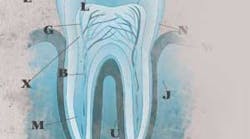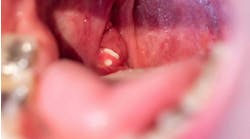The philosophy of ‘MI’ is far-reaching, addressing all areas within dentistry.
by Shirley Gutkowski, RDH
Dental hygiene is the epitome of minimal intervention. It’s what we are at the core. Like it or not, dentistry focuses on surgery, although the trend is toward something altogether different. Arguably, the terms minimally invasive and minimal intervention mean the same thing in dental hygiene. In the course of this 10-article series, the term minimal intervention (MI) will be used. MI is a philosophy that demands accurate early diagnosis and intervention. In cases where the diagnosis is late, the least amount of intervention with MI later is appropriate. The potential for an implant may be the least amount of intervention possible.
This may be a very new concept to some. MI is a philosophy, an approach to practicing dental hygiene with support from dental assistants and the administrative team; it is not a vacuum. It cannot be practiced in one department and not the other. Simply stated, MI is practicing dentistry at the highest level with the least trauma to the tissue and patient.
The World Congress of Minimally Invasive Dentistry uses this definition: “Minimally Invasive Dentistry is respecting the health, function and esthetics of oral tissue by preventing disease from occurring or intercepting its progress with minimal tissue loss.”
Many things encompass this level of treatment for all dental problems, including enamel and periodontal infections, oral cancer, and occlusion. The articles in the coming months will explore different avenues for applying the MI philosophy, with support from dental materials. Worldwide, dental companies continually develop products that make it possible to practice dentistry and dental hygiene at this level.
Clinicians must understand a few fundamentals to allow this philosophy to enter their thinking. The biggest strides in MI are occurring in caries studies. Three fundamental concepts are the genesis for caries management:
- caries is a disease caused by bacteria
- enamel heals
- caries diagnostic tools have been lacking
We learn early how enamel forms, how it breaks down, and what it takes to rebuild it. We’ve known caries as a bacterial disease for some decades. Since the mid-1900s, we’ve been treating caries as a fluoride deficiency. While fluoride has retained its place as a cornerstone in enamel healing, it is not the be-all and end-all in wiping out dental decay, the same way that amputating portions of a tooth doesn’t cure the disease.
In the late 1800s the dental explorer was perfected. Essentially it is a bent wire, and hardly worthy of the term diagnostic tool in the 20th century, not to mention the 21st. Advanced diagnostic tools are available now. These tools have been proven in offices around the world, as well as in formal studies. Using better diagnostic tools as a footing for the philosophy allows us to use the results to monitor the applied therapy, impossible with the current bent wire approach.
Caries management can start in the hands of anyone on the clinical team. A dental assistant is well qualified to assess risk, test saliva quality and quantity, and check the pH of the biofilm. These tools rival the array of medical diagnostics used to recommend treatment from strep throat to cancers.
Periodontal disease management also falls under the MI umbrella. The main diagnostic tool again falls upon a bent wire. Having markings on it elevates it a tad, but when it comes right down to it, it’s not a very sophisticated diagnostic tool to prompt the amputation of surrounding structures of the teeth. Advanced diagnostics like microscopes, paper point tests, and site-specific Volatile Sulfur Compounds (VSC) detectors can pinpoint whether periodontal infection is even present. The dental assistant is often asked to help chart an array of findings that describe the damaging affects in the disease’s path.
Current research describing the ill effects of periodontal infection on body systems stresses the importance of doing advanced testing to diagnose the disease. Blood tests to detect inflammatory markers and improper blood chemistries are not out of the question. Dental assistants perform these tests. They are fully qualified to do a paper test that lets the clinician know the status in a few minutes. The more advanced tests are like pregnancy or glucose tests, using blood samples on absorbent paper.
MI philosophy with regards to periodontal disease insists on proper risk assessment, diagnostics, and immediate, aggressive treatment. Relying on home care doesn’t lower the number of people with that infection. Oral cancer screening facilitated by the dental assistant is also a large part of MI.
Cancer starts when one single cell mutates, then others follow suit. It is imperative that oral health care providers use advanced diagnostics to detect cellular changes. Dental health care providers should use procedures that check for oral cancer at much earlier stages.
Orthodontia issues are obvious in contrast to oral cancer diagnostics. Many orthodontia cases are treated late when the entire adult dentition is present or near present. Then the treatment is directed only at the teeth, which forgets that the mouth is dynamic; the tongue, lips and even the fingers play a role in creating malocclusion. Not addressing the functional aspect of malocclusion is ignoring a large part of the comprehensive orthodontic care.
Occlusion in full mouth rehabilitation cases is also part of the MI philosophy. Those who practice full mouth dentistry using only articulating paper treat occlusion as an afterthought of beautiful smiles, when the two are inseparable. Today, electronic tools help the dentist artisan become more aware of the way teeth and muscles work in harmony to achieve an outcome that is not only beautiful, but also comfortable.
As you can see, the MI philosophy is very far reaching. A philosophy covers all areas of dentistry. In the coming issues, the role of MI in at least these four avenues will be addressed. Products for home and office will be highlighted, as will office diagnostic tools like digital X-rays, and treatment devices like ozone creators. Dentists, dental hygienists, dental assistants and the administrative team are integral to making this philosophy work for most people.
Comments and suggestions are always welcome at [email protected].
About the Author
Shirley Gutkowski, RDH, BSDH, FACE, is a practicing dental hygienist from Sun Prairie, WI. The Purple Guide: Developing Your Clinical Dental Hygiene Career is available at www.rdhpurpleguide.com by Gutkowski and Nieves. An international speaker and award winning writer, Gutkowski can be reached at [email protected].







